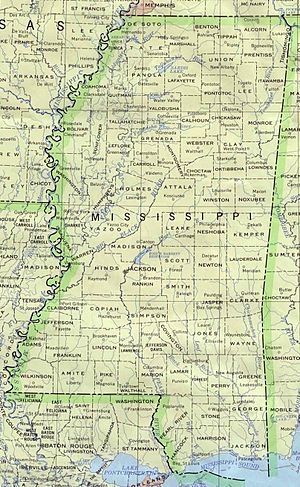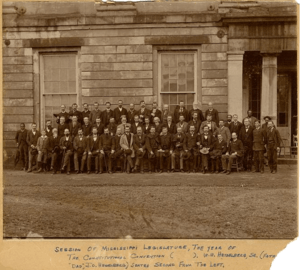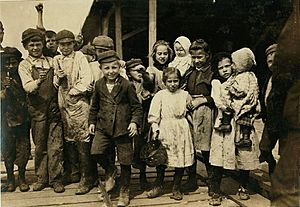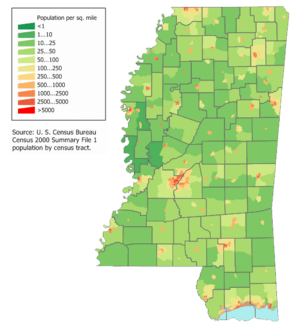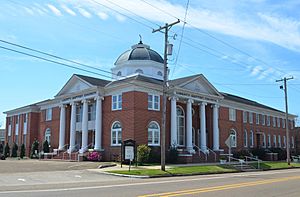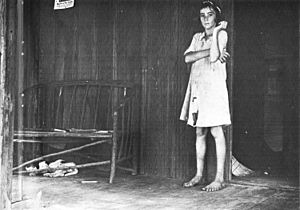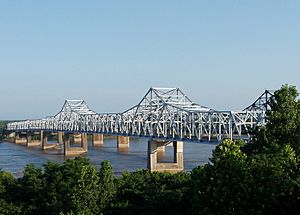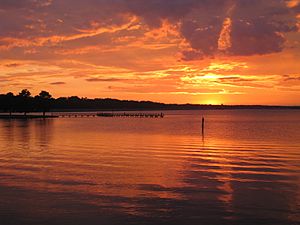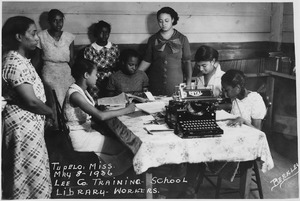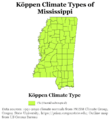Mississippi facts for kids
Quick facts for kids
Mississippi
|
|||
|---|---|---|---|
| State of Mississippi | |||
|
|||
| Nickname(s):
"The Magnolia State" and "The Hospitality State"
|
|||
| Motto(s): | |||
| Anthem: "Go, Mississippi" | |||
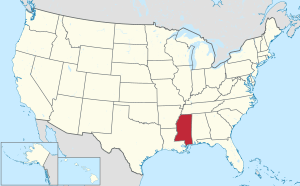
Map of the United States with Mississippi highlighted
|
|||
| Country | United States | ||
| Before statehood | Mississippi Territory | ||
| Admitted to the Union | December 10, 1817 (20th) | ||
| Capital (and largest city) |
Jackson | ||
| Largest metro | Greater Jackson | ||
| Legislature | Mississippi Legislature | ||
| • Upper house | State Senate | ||
| • Lower house | House of Representatives | ||
| U.S. senators | Roger Wicker (R) Cindy Hyde-Smith (R) |
||
| U.S. House delegation | 1: Trent Kelly (R) 2: Bennie Thompson (D) 3: Michael Guest (R) 4: Steven Palazzo (R) (list) |
||
| Area | |||
| • Total | 48,430 sq mi (125,443 km2) | ||
| • Land | 46,952 sq mi (121,607 km2) | ||
| • Water | 1,521 sq mi (3,940 km2) 3% | ||
| Area rank | 32nd | ||
| Dimensions | |||
| • Length | 340 mi (545 km) | ||
| • Width | 170 mi (275 km) | ||
| Elevation | 300 ft (90 m) | ||
| Highest elevation | 807 ft (246.0 m) | ||
| Lowest elevation | 0 ft (0 m) | ||
| Population
(2020)
|
|||
| • Total | 2,963,914 | ||
| • Rank | 35th | ||
| • Density | 63.5/sq mi (24.5/km2) | ||
| • Density rank | 32nd | ||
| • Median household income | US$43,567 | ||
| • Income rank | 50th | ||
| Demonym(s) | Mississippian | ||
| Language | |||
| • Official language | English | ||
| Time zone | UTC−06:00 (Central) | ||
| • Summer (DST) | UTC−05:00 (CDT) | ||
| USPS abbreviation |
MS
|
||
| ISO 3166 code | US-MS | ||
| Trad. abbreviation | Miss. | ||
| Latitude | 30°12′ N to 35° N | ||
| Longitude | 88°06′ W to 91°39′ W | ||
| Mississippi state symbols | |
|---|---|

|
|

|
|

|
|
| Living insignia | |
| Bird |
|
| Butterfly |
|
| Fish |
|
| Flower | Magnolia |
| Insect |
|
| Mammal | White-tailed deer (Odocoileus virginianus) |
| Reptile |
|
| Tree |
|
| Inanimate insignia | |
| Beverage | Milk |
| Colors | red and blue |
| Dance | Clogging |
| Food | Sweet potato |
| Gemstone | Emerald |
| Mineral | Gold |
| Rock | Granite |
| Shell |
|
| Slogan | Virtute et armis (Latin) |
| Toy | Teddy Bear |
| State route marker | |
 |
|
| State quarter | |

Released in 2002
|
|
| Lists of United States state symbols | |
Mississippi is a state in the Southeastern region of the United States, bordered to the north by Tennessee; to the east by Alabama; to the south by the Gulf of Mexico; to the southwest by Louisiana; and to the northwest by Arkansas. Mississippi's western boundary is largely defined by the Mississippi River. Mississippi is the 32nd largest and 35th-most populous of the 50 U.S. states. Jackson is both the state's capital and largest city. Greater Jackson is the state's most populous metropolitan area, with a population of 591,978 in 2020.
On December 10, 1817, Mississippi became the 20th state admitted to the Union. By 1860, Mississippi was the nation's top cotton-producing state and slaves accounted for 55% of the state population. Mississippi declared its secession from the Union on January 9, 1861, and was one of the seven original Confederate States, which constituted the largest slaveholding states in the nation. Following the Civil War, it was restored to the Union on February 23, 1870.
Until the Great Migration of the 1930s, African Americans were a majority of Mississippi's population. In 2010, 37.3% of Mississippi's population was African American, the highest percentage of any state. Mississippi was the site of many prominent events during the civil rights movement, including the Ole Miss riot of 1962 by white students objecting to desegregation, the 1963 assassination of Medgar Evers, and the 1964 Freedom Summer murders of three activists working on voting rights.
Mississippi frequently ranks low among U.S. states in measures of health, education, and development, while ranking high in measures of poverty. The adage "Thank God for Mississippi" became popular due to these rankings and is often said by natives of other low-ranking U.S. states, as Mississippi's extremely low ranking usually spares those states from a last place state ranking.
Mississippi is almost entirely within the Gulf coastal plain, and generally consists of lowland plains and low hills. The northwest remainder of the state consists of the Mississippi Delta, a section of the Mississippi Alluvial Plain. Mississippi's highest point is Woodall Mountain at 807 feet (246 m) above sea level adjacent to the Cumberland Plateau; the lowest is the Gulf of Mexico. Mississippi has a humid subtropical climate classification.
Contents
Etymology
The state's name is derived from the Mississippi River, which flows along its western boundary. Settlers named it after the Ojibwe word misi-ziibi ("Great River").
Geography

Mississippi is bordered on the north by Tennessee, on the east by Alabama, on the south by Louisiana and a narrow coast on the Gulf of Mexico; and on the west, across the Mississippi River, by Louisiana and Arkansas.
In addition to its namesake, major rivers in Mississippi include the Big Black River, the Pearl River, the Yazoo River, the Pascagoula River, and the Tombigbee River. Major lakes include Ross Barnett Reservoir, Arkabutla Lake, Sardis Lake, and Grenada Lake with the largest lake being Sardis Lake.
Mississippi is entirely composed of lowlands, the highest point being Woodall Mountain, in the foothills of the Cumberland Mountains, 807 feet (246 m) above sea level. The lowest point is sea level at the Gulf coast. The state's mean elevation is 300 feet (91 m) above sea level.
Most of Mississippi is part of the East Gulf Coastal Plain. The coastal plain is generally composed of low hills, such as the Pine Hills in the south and the North Central Hills. The Pontotoc Ridge and the Fall Line Hills in the northeast have somewhat higher elevations. Yellow-brown loess soil is found in the western parts of the state. The northeast is a region of fertile black earth that extends into the Alabama Black Belt.
The coastline includes large bays at Bay St. Louis, Biloxi, and Pascagoula. It is separated from the Gulf of Mexico proper by the shallow Mississippi Sound, which is partially sheltered by Petit Bois Island, Horn Island, East and West Ship Islands, Deer Island, Round Island, and Cat Island.
The northwest remainder of the state consists of the Mississippi Delta, a section of the Mississippi Alluvial Plain. The plain is narrow in the south and widens north of Vicksburg. The region has rich soil, partly made up of silt which had been regularly deposited by the flood waters of the Mississippi River.
Major cities and towns
Mississippi City Population Rankings of at least 50,000 (United States Census Bureau as of 2017):
Mississippi City Population Rankings of at least 20,000 but fewer than 50,000 (United States Census Bureau as of 2017):
- Hattiesburg (46,377)
- Biloxi (45,908)
- Tupelo (38,114)
- Meridian (37,940)
- Olive Branch (37,435)
- Greenville (30,686)
- Horn Lake (27,095)
- Pearl (26,534)
- Madison (25,627)
- Starkville (25,352)
- Clinton (25,154)
- Ridgeland (24,266)
- Columbus (24,041)
- Brandon (23,999)
- Oxford (23,639)
- Vicksburg (22,489)
- Pascagoula (21,733)
Mississippi City Population Rankings of at least 10,000 but fewer than 20,000 (United States Census Bureau as of 2017):
- Gautier (18,512)
- Laurel (18,493)
- Ocean Springs (17,682)
- Hernando (15,981)
- Clarksdale (15,732)
- Long Beach (15,642)
- Natchez (14,886)
- Corinth (14,643)
- Greenwood (13,996)
- Moss Point (13,398)
- McComb (13,267)
- Bay St. Louis (13,043)
- Canton (12,725)
- Grenada (12,267)
- Brookhaven (12,173)
- Cleveland (11,729)
- Byram (11,671)
- D'Iberville (11,610)
- Picayune (11,008)
- West Point (10,675)
- Yazoo City (11,018)
- Petal (10,633)
(See: Lists of cities, towns and villages, census-designated places, metropolitan areas, micropolitan areas, and counties in Mississippi)
Climate

Mississippi has a humid subtropical climate with long summers and short, mild winters.
The late summer and fall is the seasonal period of risk for hurricanes moving inland from the Gulf of Mexico, especially in the southern part of the state. Hurricane Camille in 1969 and Hurricane Katrina in 2005, which killed 238 people in the state, were the most devastating hurricanes to hit the state. Both caused nearly total storm surge destruction of structures in and around Gulfport, Biloxi, and Pascagoula.
As in the rest of the Deep South, thunderstorms are common in Mississippi, especially in the southern part of the state. On average, Mississippi has around 27 tornadoes annually; the northern part of the state has more tornadoes earlier in the year and the southern part a higher frequency later in the year. Two of the five deadliest tornadoes in U.S. history have occurred in the state. These storms struck Natchez, in southwest Mississippi (see The Great Natchez Tornado) and Tupelo, in the northeast corner of the state. About seven F5 tornadoes have been recorded in the state.
Ecology
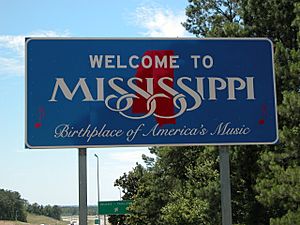
Mississippi is heavily forested, with over half of the state's area covered by wild trees, including mostly pine, as well as cottonwood, elm, hickory, oak, pecan, sweetgum and tupelo.
Ecological problems
Flooding
Due to seasonal flooding, possible from December to June, the Mississippi and Yazoo rivers and their tributaries created a fertile floodplain in the Mississippi Delta. The river's flooding created natural levees, which planters had built higher to try to prevent flooding of land cultivated for cotton crops. Temporary workers built levees along the Mississippi River on top of the natural levees that formed from dirt deposited after the river flooded.
From 1858 to 1861, the state took over levee building, accomplishing it through contractors and hired labor. In those years, planters considered their slaves too valuable to hire out for such dangerous work. Contractors hired gangs of Irish immigrant laborers to build levees and sometimes clear land. Many of the Irish were relatively recent immigrants from the famine years who were struggling to get established. Before the American Civil War, the earthwork levees averaged six feet in height, although in some areas they reached twenty feet.
Flooding has been an integral part of Mississippi history.
Even as scientific knowledge about the Mississippi River has grown, upstream development and the consequences of the levees have caused more severe flooding in some years. Scientists now understand that the widespread clearing of land and building of the levees have changed the nature of the river. Such work removed the natural protection and absorption of wetlands and forest cover, strengthening the river's current. The state and federal governments have been struggling for the best approaches to restore some natural habitats in order to best interact with the original riverine ecology.
History
Near 10,000 BC Native Americans or Paleo-Indians arrived in what today is referred to as the American South. Paleoindians in the South were hunter-gatherers who pursued the megafauna that became extinct following the end of the Pleistocene age. In the Mississippi Delta, Native American settlements and agricultural fields were developed on the natural levees, higher ground in the proximity of rivers. The Native Americans developed extensive fields near their permanent villages. Together with other practices, they created some localized deforestation but did not alter the ecology of the Mississippi Delta as a whole.
The first major European expedition into the territory that became Mississippi was that of the Spanish explorer, Hernando de Soto, who passed through the northeast part of the state in 1540, in his second expedition to the New World.
Colonial era
In April 1699, French colonists established the first European settlement at Fort Maurepas (also known as Old Biloxi), built in the vicinity of present-day Ocean Springs on the Gulf Coast.
In 1716, the French founded Natchez on the Mississippi River (as Fort Rosalie); it became the dominant town and trading post of the area. The French called the greater territory "New France"; the Spanish continued to claim part of the Gulf coast area (east of Mobile Bay) of present-day southern Alabama, in addition to the entire area of present-day Florida.
Through the eighteenth century, the area was ruled variously by Spanish, French, and British colonial governments. The colonists imported African slaves as laborers.
After Great Britain's victory in the French and Indian War (Seven Years' War), the French surrendered the Mississippi area to them under the terms of the Treaty of Paris (1763). They also ceded their areas to the north that were east of the Mississippi River, including the Illinois Country and Quebec.
United States territory
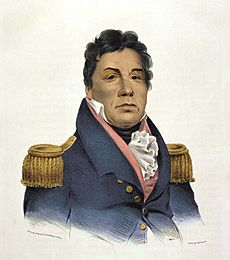
After the American Revolution, Britain ceded this area to the new United States of America. The Mississippi Territory was organized on April 7, 1798, from territory ceded by Georgia and South Carolina to the United States.
From 1800 to about 1830, the United States purchased some lands (Treaty of Doak's Stand) from Native American tribes for new settlements of European Americans. On September 27, 1830, the Treaty of Dancing Rabbit Creek was signed between the U.S. Government and the Choctaw. The Choctaw agreed to sell their traditional homelands in Mississippi and Alabama, for compensation and removal to reservations in Indian Territory (now Oklahoma).
Article 14 in the treaty allowed those Choctaw who chose to remain in the state to become U.S. citizens, the second major non-European ethnic group to do so (the Cherokee were the first). Today approximately 9,500 Choctaw live in Neshoba, Newton, Leake, and Jones counties. Federally recognized tribes include the Mississippi Band of Choctaw Indians.
Many slaveholders brought slaves with them or purchased them through the domestic slave trade, especially in New Orleans. Through the trade, nearly one million slaves were transported to the Deep South, including Mississippi, in a forced internal migration that broke up many slave families of the Upper South, where planters were selling excess slaves. The Southerners imposed slave laws and restricted the rights of free blacks, according to their view of white supremacy .
Statehood, 1817–1861
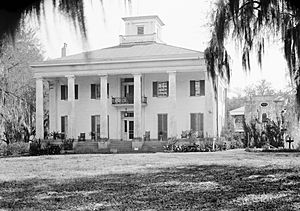
On December 10, 1817, Mississippi was the 20th state admitted to the Union.
Plantations were developed primarily along the major rivers, where the waterfront provided access to the major transportation routes. This is also where early towns developed, linked by the steamboats that carried commercial products and crops to markets. The backcountry remained largely undeveloped frontier until it was cleared by freedmen during Reconstruction and later.
When cotton was king during the 1850s, Mississippi plantation owners—especially those of the Delta and Black Belt central regions—became wealthy due to the high fertility of the soil, the high price of cotton on the international market, and their assets in slaves.
By 1860, the enslaved African-American population numbered 436,631 or 55% of the state's total of 791,305. There were fewer than 1000 free people of color.
Civil War to 20th century
On January 9, 1861, Mississippi became the second state to declare its secession from the Union, and it was one of the founding members of the Confederate States. The first six states to secede were those with the highest number of slaves.
During the war, Union and Confederate forces struggled for dominance on the Mississippi River, critical to supply routes and commerce. More than 80,000 Mississippians fought in the Civil War, and casualties were extremely heavy. Union General Ulysses S. Grant's long siege of Vicksburg finally gained the Union control of the river in 1863.
During Reconstruction, the first Mississippi constitutional convention in 1868, with delegates both black and white, framed a constitution whose major elements would be maintained for 22 years. The convention was the first political organization in the state to include African-American representatives.
Under the terms of Reconstruction, Mississippi was restored to the Union on February 23, 1870.
After the Civil War, tens of thousands of migrants were attracted to the area by higher wages offered by planters trying to develop land. In the 1870s and 1880s, many black farmers succeeded in gaining land ownership.
Democrats regained control of the state legislature in 1875, after a year of expanded violence against blacks and intimidation of whites in what was called the "white line" campaign, based on asserting white supremacy. Riots took place in Vicksburg, Clinton, Macon, and in their counties, as well-armed whites broke up black meetings and killed known black leaders, destroying local political organizations. Seeing the success of this deliberate "Mississippi Plan", South Carolina and other states followed it and also achieved white dominance.
Even in this environment, black Mississippians continued to be elected into local office. However, estimates are that 100,000 black and 50,000 white men were removed from voter registration rolls in the state over the next few years.
The loss of political influence contributed to the difficulties of African Americans in their attempts to obtain extended credit in the late 19th century. Together with imposition of Jim Crow and racial segregation laws, whites committed an increased rate of killings of blacks, mostly men, beginning in the 1890s and extending to 1930.
Cotton crops failed due to boll weevil infestation and successive severe flooding in 1912 and 1913, creating crisis conditions for many African Americans.
20th century to present
In 1900, blacks made up more than half of the state's population. By 1910, a majority of black farmers in the Delta had lost their land and become sharecroppers.
By 1920, the third generation after freedom, most African Americans in Mississippi were landless laborers again facing poverty. Starting about 1913, tens of thousands of black Americans left Mississippi for the North in the Great Migration to industrial cities such as St. Louis, Chicago, Detroit, Cleveland, Philadelphia and New York.
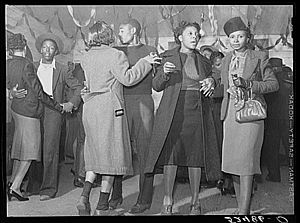
In the early 20th century, some industries were established in Mississippi, but jobs were generally restricted to whites, including child workers. The lack of jobs also drove some southern whites north to cities such as Chicago and Detroit, seeking employment, where they also competed with European immigrants. The state depended on agriculture, but mechanization put many farm laborers out of work.
The African-American call for social equality resonated throughout the Great Depression in the 1930s and World War II in the 1940s.
The Second Great Migration from the South started in the 1940s, lasting until 1970. Almost half a million people left Mississippi in the second migration, three-quarters of them black. The Second Great Migration included destinations in the West, especially California, where the buildup of the defense industry offered higher paying jobs to both African Americans and whites.
Blacks and whites in Mississippi generated rich, quintessentially American music traditions: gospel music, country music, jazz, blues and rock and roll. All were invented, promulgated or heavily developed by Mississippi musicians, many of them African American, and most came from the Mississippi Delta. Many musicians carried their music north to Chicago, where they made it the heart of that city's jazz and blues.
So many African Americans left in the Great Migration that after the 1930s, they became a minority in Mississippi.
The Civil Rights Movement had many roots in religion, and the strong community of churches helped supply volunteers and moral purpose for their activism. Mississippi was a center of activity, based in black churches, to educate and register black voters, and to work for integration.
After decades of disenfranchisement, African Americans in the state gradually began to exercise their right to vote again for the first time since the 19th century, following the passage of federal civil rights legislation in 1964 and 1965, which ended de jure segregation and enforced constitutional voting rights.
On August 17, 1969, Category 5 Hurricane Camille hit the Mississippi coast, killing 248 people and causing US$1.5 billion in damage (1969 dollars).
On August 29, 2005, Hurricane Katrina, though a Category 3 storm upon final landfall, caused even greater destruction across the entire 90 miles (145 km) of the Mississippi Gulf Coast from Louisiana to Alabama.
Demographics
| Historical population | |||
|---|---|---|---|
| Census | Pop. | %± | |
| 1800 | 7,600 | — | |
| 1810 | 31,306 | 311.9% | |
| 1820 | 75,448 | 141.0% | |
| 1830 | 136,621 | 81.1% | |
| 1840 | 375,651 | 175.0% | |
| 1850 | 606,526 | 61.5% | |
| 1860 | 791,305 | 30.5% | |
| 1870 | 827,922 | 4.6% | |
| 1880 | 1,131,597 | 36.7% | |
| 1890 | 1,289,600 | 14.0% | |
| 1900 | 1,551,270 | 20.3% | |
| 1910 | 1,797,114 | 15.8% | |
| 1920 | 1,790,618 | −0.4% | |
| 1930 | 2,009,821 | 12.2% | |
| 1940 | 2,183,796 | 8.7% | |
| 1950 | 2,178,914 | −0.2% | |
| 1960 | 2,178,141 | 0.0% | |
| 1970 | 2,216,912 | 1.8% | |
| 1980 | 2,520,638 | 13.7% | |
| 1990 | 2,573,216 | 2.1% | |
| 2000 | 2,844,658 | 10.5% | |
| 2010 | 2,967,297 | 4.3% | |
| 2020 | 2,961,279 | −0.2% | |
| Source: 1910–2020 | |||
The center of population of Mississippi is located in Leake County, in the town of Lena.
The United States Census Bureau estimates that the population of Mississippi was 2,976,149 on July 1, 2019, a 0.30% increase since the 2010 census. The state's economist characterized the state as losing population as job markets elsewhere have caused 3.2 per 1000 to migrate recently.
From 2000 to 2010, the United States Census Bureau reported that Mississippi had the highest rate of increase in people identifying as mixed-race, up 70 percent in the decade; it amounts to a total of 1.1 percent of the population. In addition, Mississippi led the nation for most of the last decade in the growth of mixed marriages among its population. The total population has not increased significantly, but is young. Some of the above change in identification as mixed race is due to new births. But, it appears mostly to reflect those residents who have chosen to identify as more than one race, who in earlier years may have identified by just one ethnicity. A binary racial system had been in place since slavery times and the days of official government racial segregation. In the civil rights era, people of African descent banded together in an inclusive community to achieve political power and gain restoration of their civil rights.
As the demographer William H. Frey noted, "In Mississippi, I think it's [identifying as mixed race] changed from within." Historically in Mississippi, after Indian removal in the 1830s, the major groups were designated as black (African American), who were then mostly enslaved, and white (primarily European American). Matthew Snipp, also a demographer, commented on the increase in the 21st century in the number of people identifying as being of more than one race: "In a sense, they're rendering a more accurate portrait of their racial heritage that in the past would have been suppressed."
After having accounted for a majority of the state's population since well before the Civil War and through the 1930s, today African Americans constitute approximately 37.8 percent of the state's population. Most have ancestors who were enslaved, with many forcibly transported from the Upper South in the 19th century to work on the area's new plantations. Many of these slaves were mixed race, with European ancestors, as there were many children born into slavery with white fathers. Some also have Native American ancestry. During the first half of the 20th century, a total of nearly 400,000 African Americans left the state during the Great Migration, for opportunities in the North, Midwest and West. They became a minority in the state for the first time since early in its development.
Ancestry
| Race and Ethnicity | Alone | Total | ||
|---|---|---|---|---|
| White (non-Hispanic) | 55.4% |
|
57.9% |
|
| African American (non-Hispanic) | 36.4% |
|
37.6% |
|
| Hispanic or Latino | — | 3.6% |
|
|
| Asian | 1.1% |
|
1.5% |
|
| Native American | 0.5% |
|
1.6% |
|
| Pacific Islander | 0.04% |
|
0.1% |
|
| Other | 0.2% |
|
0.7% |
|
| Racial composition | 1990 | 2000 | 2010 |
|---|---|---|---|
| White | 63.5% | 61.4% | 59.1% |
| Black | 35.6% | 36.3% | 37.0% |
| Asian | 0.5% | 0.7% | 0.9% |
| Native | 0.3% | 0.4% | 0.5% |
| Other race | 0.1% | 0.5% | 1.3% |
| Two or more races | – | 0.7% | 1.2% |
As of 2011, 53.8% of Mississippi's population younger than age 1 were minorities, meaning that they had at least one parent who was not non-Hispanic white. For more information on racial and ethnic classifications in the United States see race and ethnicity in the United States Census.
Americans of Scots-Irish, English and Scottish ancestry are present throughout the state. It is believed that there are more people with such ancestry than identify as such on the census, in part because their immigrant ancestors are more distant in their family histories. English, Scottish and Scots-Irish are generally the most under-reported ancestry groups in both the South Atlantic States and the East South Central States. The historian David Hackett Fischer estimated that a minimum 20% of Mississippi's population is of English ancestry, though the figure is probably much higher, and another large percentage is of Scottish ancestry. Many Mississippians of such ancestry identify simply as American on questionnaires, because their families have been in North America for centuries. In the 1980 census 656,371 Mississippians of a total of 1,946,775 identified as being of English ancestry, making them 38% of the state at the time.
The state in 2010 had the highest proportion of African Americans in the nation. The African-American percentage of population has begun to increase due mainly to a younger population than the whites (the total fertility rates of the two races are approximately equal). Due to patterns of settlement and whites putting their children in private schools, in almost all of Mississippi's public school districts, a majority of students are African American. African Americans are the majority ethnic group in the northwestern Yazoo Delta, and the southwestern and the central parts of the state. These are areas where, historically, African Americans owned land as farmers in the 19th century following the Civil War, or worked on cotton plantations and farms.
People of French Creole ancestry form the largest demographic group in Hancock County on the Gulf Coast. The African-American; Choctaw, mostly in Neshoba County; and Chinese American portions of the population are also almost entirely native born.
The Chinese first came to Mississippi as contract workers from Cuba and California in the 1870s, and they originally worked as laborers on the cotton plantations. However, most Chinese families came later between 1910 and 1930 from other states, and most operated small family-owned groceries stores in the many small towns of the Delta. In these roles, the ethnic Chinese carved out a niche in the state between black and white, where they were concentrated in the Delta. These small towns have declined since the late 20th century, and many ethnic Chinese have joined the exodus to larger cities, including Jackson. Their population in the state overall has increased in the 21st century.
In the early 1980s many Vietnamese immigrated to Mississippi and other states along the Gulf of Mexico, where they became employed in fishing-related work.
Language
In 2000, 96.4% of Mississippi residents five years old and older spoke only English in the home, a decrease from 97.2% in 1990. English is largely Southern American English, with some South Midland speech in northern and eastern Mississippi. There is a common absence of final /r/, particularly in the elderly natives and African Americans, and the lengthening and weakening of the diphthongs /aɪ/ and /ɔɪ/ as in 'ride' and 'oil'. South Midland terms in northern Mississippi include: tow sack (burlap bag), dog irons (andirons), plum peach (clingstone peach), snake doctor (dragonfly), and stone wall (rock fence).
| Language | Percentage of population (as of 2010) |
|---|---|
| Spanish | 1.9% |
| French | 0.4% |
| German, Vietnamese, and Choctaw (tied) | 0.2% |
| Korean, Chinese, Tagalog, Italian (tied) | 0.1% |
Religion
Under French and Spanish rule beginning in the 17th century, European colonists were mostly Roman Catholics. The growth of the cotton culture after 1815 brought in tens of thousands of Anglo-American settlers each year, most of whom were Protestants from Southeastern states. Due to such migration, there was rapid growth in the number of Protestant churches, especially Methodist, Presbyterian and Baptist.
The revivals of the Great Awakening in the late 18th and early 19th centuries initially attracted the "plain folk" by reaching out to all members of society, including women and blacks. Both slaves and free blacks were welcomed into Methodist and Baptist churches. Independent black Baptist churches were established before 1800 in Virginia, Kentucky, South Carolina and Georgia, and later developed in Mississippi as well.
In the post-Civil War years, religion became more influential as the South became known as the "Bible Belt".
Since the 1970s, fundamentalist conservative churches have grown rapidly, fueling Mississippi's conservative political trends among whites. In 1973 the Presbyterian Church in America attracted numerous conservative congregations. As of 2010, Mississippi remained a stronghold of the denomination, which originally was brought by Scots immigrants. The state has the highest adherence rate of the PCA in 2010, with 121 congregations and 18,500 members. It is among the few states where the PCA has higher membership than the PC(USA). According to the Association of Religion Data Archives (ARDA), in 2010 the Southern Baptist Convention had 907,384 adherents and was the largest religious denomination in the state, followed by the United Methodist Church with 204,165, and the Roman Catholic Church with 112,488. Other religions have a small presence in Mississippi; as of 2010, there were 5,012 Muslims; 4,389 Hindus; and 816 of the Baháʼí Faith.
Public opinion polls have consistently ranked Mississippi as the most religious state in the United States, with 59% of Mississippians considering themselves "very religious". The same survey also found that 11% of the population were non-Religious. In a 2009 Gallup poll, 63% of Mississippians said that they attended church weekly or almost weekly—the highest percentage of all states (U.S. average was 42%, and the lowest percentage was in Vermont at 23%). Another 2008 Gallup poll found that 85% of Mississippians considered religion an important part of their daily lives, the highest figure among all states (U.S. average 65%).
| Affiliation | % of Mississippi population | |
|---|---|---|
| Christian | 83 |
|
| Protestant | 77 |
|
| Evangelical Protestant | 41 |
|
| Mainline Protestant | 12 |
|
| Black church | 24 |
|
| Catholic | 4 |
|
| Mormon | 1 |
|
| Jehovah's Witnesses | 0.5 |
|
| Eastern Orthodox | 0.5 |
|
| Other Christian | 0.5 |
|
| Unaffiliated | 14 |
|
| Nothing in particular | 11 |
|
| Agnostic | 3 |
|
| Atheist | 1 |
|
| Non-Christian faiths | 2 |
|
| Jewish | 0.5 |
|
| Muslim | 0.5 |
|
| Buddhist | 0.5 |
|
| Hindu | 0.5 |
|
| Other Non-Christian faiths | 0.5 |
|
| Don't know/refused answer | 1 |
|
| Total | 100 |
|
LGBT
The 2010 United States Census counted 6,286 same-sex unmarried-partner households in Mississippi, an increase of 1,512 since the 2000 United States census. Of those same-sex couples roughly 33% contained at least one child, giving Mississippi the distinction of leading the nation in the percentage of same-sex couples raising children. Mississippi has the largest percentage of African-American same-sex couples among total households. The state capital, Jackson, ranks tenth in the nation in concentration of African-American same-sex couples. The state ranks fifth in the nation in the percentage of Hispanic same-sex couples among all Hispanic households and ninth in the highest concentration of same-sex couples who are seniors.
Economy

The Bureau of Economic Analysis estimates that Mississippi's total state product in 2010 was $98 billion. GDP growth was .5 percent in 2015 and is estimated to be 2.4 in 2016 according to Dr. Darrin Webb, the state's chief economist, who noted it would make two consecutive years of positive growth since the recession. Per capita personal income in 2006 was $26,908, the lowest per capita personal income of any state, but the state also has the nation's lowest living costs. 2015 data records the adjusted per capita personal income at $40,105. Mississippians consistently rank as one of the highest per capita in charitable contributions.
At 56 percent, the state has one of the lowest workforce participation rates in the country. Approximately 70,000 adults are disabled, which is 10 percent of the workforce.
Mississippi's rank as one of the poorest states is related to its dependence on cotton agriculture before and after the Civil War, late development of its frontier bottomlands in the Mississippi Delta, repeated natural disasters of flooding in the late 19th and early 20th century that required massive capital investment in levees, and ditching and draining the bottomlands, and slow development of railroads to link bottomland towns and river cities. In addition, when Democrats regained control of the state legislature, they passed the 1890 constitution that discouraged corporate industrial development in favor of rural agriculture, a legacy that would slow the state's progress for years.
Before the Civil War, Mississippi was the fifth-wealthiest state in the nation, its wealth generated by the labor of slaves in cotton plantations along the rivers. Slaves were counted as property and the rise in the cotton markets since the 1840s had increased their value. By 1860, a majority—55 percent—of the population of Mississippi was enslaved. Ninety percent of the Delta bottomlands were undeveloped and the state had low overall density of population.
Largely due to the domination of the plantation economy, focused on the production of agricultural cotton, the state's elite was reluctant to invest in infrastructure such as roads and railroads. They educated their children privately. Industrialization did not reach many areas until the late 20th century. The planter aristocracy, the elite of antebellum Mississippi, kept the tax structure low for their own benefit, making only private improvements. Before the war the most successful planters, such as Confederate President Jefferson Davis, owned riverside properties along the Mississippi and Yazoo rivers in the Mississippi Delta. Away from the riverfronts, most of the Delta was undeveloped frontier.
During the Civil War, 30,000 Mississippi soldiers, mostly white, died from wounds and disease, and many more were left crippled and wounded. Changes to the labor structure and an agricultural depression throughout the South caused severe losses in wealth. In 1860 assessed valuation of property in Mississippi had been more than $500 million, of which $218 million (43 percent) was estimated as the value of slaves. By 1870, total assets had decreased in value to roughly $177 million.
Poor whites and landless former slaves suffered the most from the postwar economic depression. The constitutional convention of early 1868 appointed a committee to recommend what was needed for relief of the state and its citizens. The committee found severe destitution among the laboring classes. It took years for the state to rebuild levees damaged in battles. The upset of the commodity system impoverished the state after the war. By 1868 an increased cotton crop began to show possibilities for free labor in the state, but the crop of 565,000 bales produced in 1870 was still less than half of prewar figures.
Blacks cleared land, selling timber and developing bottomland to achieve ownership. In 1900, two-thirds of farm owners in Mississippi were blacks, a major achievement for them and their families. Due to the poor economy, low cotton prices and difficulty of getting credit, many of these farmers could not make it through the extended financial difficulties. Two decades later, the majority of African Americans were sharecroppers. The low prices of cotton into the 1890s meant that more than a generation of African Americans lost the result of their labor when they had to sell their farms to pay off accumulated debts.
After the Civil War, the state refused for years to build human capital by fully educating all its citizens. In addition, the reliance on agriculture grew increasingly costly as the state suffered loss of cotton crops due to the devastation of the boll weevil in the early 20th century, devastating floods in 1912–1913 and 1927, collapse of cotton prices after 1920, and drought in 1930.
It was not until 1884, after the flood of 1882, that the state created the Mississippi-Yazoo Delta District Levee Board and started successfully achieving longer-term plans for levees in the upper Delta. Despite the state's building and reinforcing levees for years, the Great Mississippi Flood of 1927 broke through and caused massive flooding of 27,000 square miles (70,000 km2) throughout the Delta, homelessness for hundreds of thousands, and millions of dollars in property damages. With the Depression coming so soon after the flood, the state suffered badly during those years. In the Great Migration, hundreds of thousands of African Americans migrated North and West for jobs and chances to live as full citizens.
Entertainment and tourism
The legislature's 1990 decision to legalize casino gambling along the Mississippi River and the Gulf Coast has led to increased revenues and economic gains for the state. Gambling towns in Mississippi have attracted increased tourism: they include the Gulf Coast resort towns of Bay St. Louis, Gulfport and Biloxi, and the Mississippi River towns of Tunica (the third largest gaming area in the United States), Greenville, Vicksburg and Natchez.
Before Hurricane Katrina struck the Gulf Coast, Mississippi was the second-largest gambling state in the Union, after Nevada and ahead of New Jersey. An estimated $500,000 per day in tax revenue was lost following Hurricane Katrina's severe damage to several coastal casinos in Biloxi in August 2005. Because of the destruction from this hurricane, on October 17, 2005, Governor Haley Barbour signed a bill into law that allows casinos in Hancock and Harrison counties to rebuild on land (but within 800 feet (240 m) of the water). The only exception is in Harrison County, where the new law states that casinos can be built to the southern boundary of U.S. Route 90.
In 2012, Mississippi had the sixth largest gambling revenue of any state, with $2.25 billion. The federally recognized Mississippi Band of Choctaw Indians has established a gaming casino on its reservation, which yields revenue to support education and economic development.
Momentum Mississippi, a statewide, public–private partnership dedicated to the development of economic and employment opportunities in Mississippi, was adopted in 2005.
Manufacturing

Mississippi, like the rest of its southern neighbors, is a right-to-work state. It has some major automotive factories, such as the Toyota Mississippi Plant in Blue Springs and a Nissan Automotive plant in Canton. The latter produces the Nissan Titan.
Taxation
Mississippi collects personal income tax in three tax brackets, ranging from 3% to 5%. The retail sales tax rate in Mississippi is 7%. Tupelo levies a local sales tax of 2.5%. State sales tax growth was 1.4 percent in 2016 and estimated to be slightly less in 2017. For purposes of assessment for ad valorem taxes, taxable property is divided into five classes.
On August 30, 2007, a report by the United States Census Bureau indicated that Mississippi was the poorest state in the country. Major cotton farmers in the Delta have large, mechanized plantations, and they receive the majority of extensive federal subsidies going to the state, yet many other residents still live as poor, rural, landless laborers. The state's sizable poultry industry has faced similar challenges in its transition from family-run farms to large mechanized operations. Of $1.2 billion from 2002 to 2005 in federal subsidies to farmers in the Bolivar County area of the Delta, only 5% went to small farmers. There has been little money apportioned for rural development. Small towns are struggling. More than 100,000 people have left the region in search of work elsewhere. The state had a median household income of $34,473.
Employment
As of December 2018, the state's unemployment rate was 4.7%, the seventh highest in the country after Arizona (4.9%), Louisiana (4.9%), New Mexico (5.0%), West Virginia (5.1%), District of Columbia (5.4%) and Alaska (6.5%).
Federal subsidies and spending
With Mississippi's fiscal conservatism, in which Medicaid, welfare, food stamps, and other social programs are often cut, eligibility requirements are tightened, and stricter employment criteria are imposed, Mississippi ranks as having the second-highest ratio of spending to tax receipts of any state. In 2005, Mississippi citizens received approximately $2.02 per dollar of taxes in the way of federal spending. This ranks the state second-highest nationally, and represents an increase from 1995, when Mississippi received $1.54 per dollar of taxes in federal spending and was 3rd highest nationally. This figure is based on federal spending after large portions of the state were devastated by Hurricane Katrina, requiring large amounts of federal aid from the Federal Emergency Management Agency (FEMA). However, from 1981 to 2005, it was at least number four in the nation for federal spending vs. taxes received.
A proportion of federal spending in Mississippi is directed toward large federal installations such as Camp Shelby, John C. Stennis Space Center, Meridian Naval Air Station, Columbus Air Force Base, and Keesler Air Force Base. Three of these installations are located in the area affected by Hurricane Katrina.
Transportation
Air
Mississippi has six airports with commercial passenger service, the busiest in Jackson (Jackson-Evers International Airport) and one in Gulfport (Gulfport-Biloxi International Airport)
Roads
Mississippi is the only American state where people in cars may legally consume beer. Some localities have laws restricting the practice. In 2018, the state was ranked number eight in the Union in terms of impaired driving deaths.
Mississippi is served by nine interstate highways:
|
and fourteen main U.S. Routes:
|
as well as a system of State Highways.
Rail
Passenger
Amtrak provides scheduled passenger service along two routes, the Crescent and City of New Orleans. Prior to severe damage from Hurricane Katrina, the Sunset Limited traversed the far south of the state; the route originated in Los Angeles, California and it terminated in Florida.
Freight
All but two of the United States Class I railroads serve Mississippi (the exceptions are the Union Pacific and Canadian Pacific):
- Canadian National Railway's Illinois Central Railroad subsidiary provides north–south service.
- BNSF Railway has a northwest–southeast line across northern Mississippi.
- Kansas City Southern Railway provides east–west service in the middle of the state and north–south service along the Alabama state line.
- Norfolk Southern Railway provides service in the extreme north and southeast.
- CSX has a line along the Gulf Coast.
Water
Major rivers
- Mississippi River
- Big Black River
- Pascagoula River
- Pearl River
- Tennessee-Tombigbee Waterway
- Yazoo River
Major bodies of water
- Arkabutla Lake 19,550 acres (79.1 km2) of water; constructed and managed by the U.S. Army Corps of Engineers Vicksburg District
- Bay Springs Lake 6,700 acres (27 km2) of water and 133 miles (214 km) of shoreline; constructed and managed by the U.S. Army Corps of Engineers
- Grenada Lake 35,000 acres (140 km2) of water; became operational in 1954; constructed and managed by the U.S. Army Corps of Engineers Vicksburg District
- Ross Barnett Reservoir 33,000 acres (130 km2) of water; named for Ross Barnett, the 52nd Governor of Mississippi; became operational in 1966; constructed and managed by The Pearl River Valley Water Supply District, a state agency; provides water supply for the City of Jackson.
- Sardis Lake 98,520 acres (398.7 km2) of water; became operational in October 1940; constructed and managed by the U.S. Army Corps of Engineers Vicksburg District
- Enid Lake 44,000 acres (180 km2) of water; constructed and managed by the U.S. Army
Enid Lake
Culture
While Mississippi has been especially known for its music and literature, it has embraced other forms of art. Its strong religious traditions have inspired striking works by outsider artists who have been shown nationally.
Jackson established the USA International Ballet Competition, which is held every four years. This ballet competition attracts the most talented young dancers from around the world.
The Magnolia Independent Film Festival, still held annually in Starkville, is the first and oldest in the state.
George Ohr, known as the "Mad Potter of Biloxi" and the father of abstract expressionism in pottery, lived and worked in Biloxi, MS.
Music

Musicians of the state's Delta region were historically significant to the development of the blues.
Jimmie Rodgers, a native of Meridian and guitarist/singer/songwriter known as the "Father of Country Music", played a significant role in the development of the blues.
The state is creating a Mississippi Blues Trail, with dedicated markers explaining historic sites significant to the history of blues music, such as Clarksdale's Riverside Hotel, where Bessie Smith died after her auto accident on Highway 61. The Riverside Hotel is just one of many historical blues sites in Clarksdale. The Delta Blues Museum there is visited by tourists from all over the world. Close by is "Ground Zero", a contemporary blues club and restaurant co-owned by actor Morgan Freeman.
Elvis Presley, who created a sensation in the 1950s as a crossover artist and contributed to rock 'n' roll, was a native of Tupelo. From opera star Leontyne Price to the alternative rock band 3 Doors Down, to gulf and western singer Jimmy Buffett, modern rock/jazz/world music guitarist-producer Clifton Hyde, to rappers David Banner, Big K.R.I.T. and Afroman, Mississippi musicians have been significant in all genres.
In popular culture
- Children in the United States and Canada often count "One-Mississippi, two-Mississippi" during informal games such as hide and seek to approximate counting by seconds.
- Mississippi's low state rankings has given rise to the saying "Thank God for Mississippi", denoting relief that the speaker's state isn't the lowest.
- On March 12, 1894, the Biedenharn Candy Company bottled the first Coca-Cola in Vicksburg, Mississippi. Root beer was invented in Biloxi in 1898 by Edward Adolf Barq, the namesake of Barq's Root Beer.
- The Teddy bear gets its name from President Theodore "Teddy" Roosevelt. On a 1902 hunting trip to Sharkey County, Mississippi, he ordered the mercy killing of a wounded bear.
- In 1935, the world's first night rodeo held outdoors under electric lights was produced by Earl Bascom and Weldon Bascom in Columbia, Marion County, Mississippi
- In 1936, Dr. Leslie Rush, of Rush Hospital in Meridian, Mississippi, performed the first bone pinning in the United States. The "Rush Pin" is still in use.
- Burnita Shelton Matthews from near Hazlehurst, Mississippi, was the first woman appointed as a judge of a U.S. district court. She was appointed by Harry S. Truman on October 21, 1949.
- Marilyn Monroe won the Mrs. Mississippi finals in the 1952 film We're Not Married!.
- Texas Rose Bascom, of Columbia, Mississippi, became the most famous female trick roper in the world, performing on stage and in Hollywood movies. She toured the world with Bob Hope, billed as the "Queen of the Trick Ropers", and was the first Mississippian to be inducted into the National Cowgirl Hall of Fame.
- In 1963, Dr. James D. Hardy of the University of Mississippi Medical Center performed the first human lung transplant in Jackson, Mississippi. In 1964, Dr. Hardy performed the first heart transplant, transplanting the heart of a chimpanzee into a human, where it beat for 90 minutes.
- "At 10:00 a.m. on October 22, 1964, the United States government detonated an underground nuclear device in Lamar County, in south Mississippi. (...) The Project Salmon blast was about one-third as powerful as the bomb that destroyed Hiroshima in 1945. (...) The Project Sterling blast, on December 3, 1966, was considerably weaker than the blast two years earlier, as it was intended to be."
- On January 8, 1935, Elvis Presley was born in Tupelo.
- Several warships have been named USS Mississippi.
- The comic book character Rogue, from the well-known series X-Men, is a Mississippian and self-declared southern belle. Her home town is located in the fictional county of Caldecott.
- In 2013, researchers at the University of Mississippi Medical Center discovered a functional cure for HIV/AIDS in infants.
- Many of legal thriller writer John Grisham's novels are set in and around the fictional town of Clanton, in the equally fictional Ford County, northwest Mississippi.
- In Star Trek, Dr. Leonard "Bones" McCoy, Chief Medical Officer on the U.S.S. Enterprise, studied medicine at the University of Mississippi Medical Center.
- Johnny Carson attended Millsaps College under an elite Navy program to train officers, known as the V-12 Program from November 1943 to February 1945.
- The film Mississippi Burning is based around the FBI investigation of events that occurred there in 1964 where three civil rights workers were murdered. It stars Gene Hackman and Willem Dafoe.
Education
Until the Civil War era, Mississippi had a small number of schools and no educational institutions for African Americans. The first school for black students was not established until 1862.
During Reconstruction in 1871, black and white Republicans drafted a constitution that was the first to provide for a system of free public education in the state. The state's dependence on agriculture and resistance to taxation limited the funds it had available to spend on any schools. In the early 20th century, there were still few schools in rural areas, particularly for black children. With seed money from the Julius Rosenwald Fund, many rural black communities across Mississippi raised matching funds and contributed public funds to build new schools for their children. Essentially, many black adults taxed themselves twice and made significant sacrifices to raise money for the education of children in their communities, in many cases donating land and/or labor to build such schools.
Blacks and whites attended segregated and separate public schools in Mississippi until the late 1960s, although such segregation had been declared unconstitutional by the United States Supreme Court in its 1954 ruling in Brown v. Board of Education. In the majority-black Mississippi Delta counties, white parents worked through White Citizens' Councils to set up private segregation academies, where they enrolled their children. Often funding declined for the public schools.
But in the state as a whole, only a small minority of white children were withdrawn from public schools. State officials believed they needed to maintain public education to attract new businesses. Many black parents complained that they had little representation in school administration, and that many of their former administrators and teachers had been pushed out. They have had to work to have their interests and children represented.
In the late 1980s Mississippi's 954 public schools enrolled about 369,500 elementary and 132,500 secondary students. Some 45,700 students attended private schools.
In the 21st century, 91% of white children and most of the black children in the state attend public schools. In 2008, Mississippi was ranked last among the fifty states in academic achievement by the American Legislative Exchange Council's Report Card on Education, with the lowest average ACT scores and sixth-lowest spending per pupil in the nation. In contrast, Mississippi had the 17th-highest average SAT scores in the nation. As an explanation, the Report noted that 92% of Mississippi high school graduates took the ACT, but only 3% of graduates took the SAT, apparently a self-selection of higher achievers. This breakdown compares to the national average of high school graduates taking the ACT and SAT, of 43% and 45%, respectively.
Generally prohibited in the West at large, school corporal punishment is not unusual in Mississippi, with 31,236 public school students paddled at least one time circa 2016. A greater percentage of students were paddled in Mississippi than in any other state, according to government data for the 2011–2012 school year.
In 2007, Mississippi students scored the lowest of any state on the National Assessments of Educational Progress in both math and science.
Jackson, the state's capital city, is the site of the state residential school for deaf and hard of hearing students. The Mississippi School for the Deaf was established by the state legislature in 1854 before the civil war.
Images for kids
-
Confederate lines, Vicksburg, May 19, 1863. Shows assault by US 1st Battalion, 13th Infantry
-
Mexican American boy and African American man at the Knowlton Plantation, Perthshire, Mississippi, in 1939, by Marion Post Wolcott
-
Köppen climate types of Mississippi, using 1991-2020 climate normals.
-
The Mississippi State Capitol was designated a National Historic Landmark in 2016.
See also
 In Spanish: Misisipi para niños
In Spanish: Misisipi para niños





